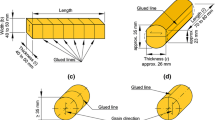Abstract
The problem of making inference on the performance of glued-laminated timber beams based on the shear strength of core samples is discussed. For the assessment of glued-laminated beams in existing structures, engineers are left with little guidance; often the standard for shear test of glue-lines (EN 392) is applied to evaluate aged or damaged components. Since the quality of the glue-line can vary significantly within and between members, multiple samples must be taken to get global estimates. The inherent limitations of the procedure are illustrated by the case study presented herein. Samples were taken from the beams of a decommissioned skating rink in Switzerland on different structural levels. A total of 20 bending and 128 shear tests were carried out on a representative large scale; additionally, 728 shear tests on small-scale core samples were conducted. The results demonstrate that core samples can be used to derive the local shear strength of glue-lines; however, no correlation with the shear and bending strength of adjacent large-scale beam sections was found. The results demonstrate that the common practice of assessing glued laminated timber based on the glue-line strength of core samples has to be critically re-evaluated; practical recommendations on how to improve the assessment are given.










Similar content being viewed by others
References
Kasal B, Tannert T (2011) RILEM state-of-the-art report 7. In: Kasal B, Tannert T (eds). In situ assessment of timber. Springer, New York. ISBN 978-94-007-0559-3
Dietsch P, Köhler J (2010) Report COST Action E55. In: Methods for the assessment of timber structures. Shaker, Munich. ISBN 978-3-8322-9513-4
Kasal B, Anthony RW (2004) Advances in in situ evaluation of timber structures. Prog Struct Eng Mater 6:94–103
Winter S, Kreuzinger H (2008) The Bad Reichenhall ice-arena collapse and the necessary consequences for wide span timber structures. In: Proceedings of tenth world conference on timber engineering, June 2–5, Miyazaki, Japan
Frese M, Blass HJ (2011) Statistics of damages to timber structures in Germany. Eng Struct. doi:10.1016/j.engstruct.2011.02.030
EN 391 (2001) Glued laminated timber. Delamination test of glue lines. European Committee for Standardization (CEN), Brussels
EN 392 (1995) Glued laminated timber. Shear test of glue-lines. European Committee for Standardization (CEN), Brussels
Aicher S, Dill-Langer G (2008) Non-destructive detection of glue line defects in glued laminated timber. In: Proceedings of tenth world conference on timber engineering, June 2–5, Miyazaki, Japan
Sanabria SJ, Mueller C, Neuenschwander J, Niemz P, Sennhauser U (2011) Air-coupled ultrasound as an accurate and reproducible method for bonding assessment of glued timber. Wood Sci Technol. doi:10.1007/s00226-010-0357-z
ASTM D 905-03 (2003) Standard test method for strength properties of adhesive bonds in shear by compression loading. ASTM International, West Conshohocken
Tannert T (2011) Shear test of glue lines, chap 6. In: Kasal B, Tannert T (eds) RILEM state of the art reports, vol 7. doi:10.1007/978-94-007-0560-9
EN 386 (2001) Glued laminated timber. In: Performance requirements and minimum production requirements. European Committee for Standardization (CEN), Brussels
ASTM D 5266 (2003) Standard practice for estimating the percentage of wood failure in adhesive bonded joints. ASTM International, West Conshohocken
CSA/A370/SC05.3 (2002) Wood failure round robin report. Canadian Standards Association. Mississauga, Ontario
Yang Y, Gong M, Chui YH (2008) A new image analysis algorithm for calculating percentage wood failure. Holzforschung 62:248–251
Gaspar F, Cruz H, Gomes A (2008) Evaluation of glued laminated timber structures—core extraction and shear testing. In: Proceedings of tenth world conference on timber engineering, June 2–5, Miyazaki, Japan
Selbo ML (1962) A new method for testing glue joints of laminated timber in service. For Prod J 12:65–67
Outinen K, Koponen S (2001) Drilled shear specimen (DSS). In: Proceedings of conference on COST E13, Edinburgh, Scotland
Brüninghoff H (2007) Reinforcement/rehabilitation of glulam structures. In: Proceedings of international Holzbauforum. Garmisch-Partenkirchen, Germany
Steiger R, Risi W, Gehri E (2007) Quality control of glulam: shear tests of glue-lines. In: Proceedings of fortieth meeting CIB-W18. Bled, Slovenia, Paper 40-12-7
Feuerer M (2009) Beurteilung von Brettschichtholz im Bestand Beziehungen von Kleinproben und Tragwerk. Diploma thesis, Technical University Munich, Germany
Scharmacher F (2011) Untersuchungsmethoden zur Bestimmung der Klebstofffugenqualität. Zulassungsarbeit zum MSE Bericht Nr. 2783-PB-01, Bern University of Applied Sciences
EN 408 (2003) Timber structures: structural timber and glued laminated timber—determination of some physical and mechanical properties. European Committee for Standardization (CEN), Brussels
Vallée T, Tannert T, Murcia J, Quinn D (2010) Influence of stress reduction methods on the strength of adhesively bonded joints composed of brittle adherends. Int J Adhes Adhes 30(7):583–594
Tannert T, Vallée T, Hehl S (2012) Experimental and numerical investigations on adhesively bonded timber joints. Wood Sci Technol 46:579–590. doi:10.1007/s00226-011-0423-1
Khokhar A, Zhang H, Ridley-Ellis D (2010) The shear strength, and failure modes, of timber joists obtained from the torsion test method. In: Proceedings of 11th world conference on timber engineering, June 20–24, Riva del Garda, Italy
Gupta RL, Heck R, Miller TH (2002) Experimental evaluation of the torsion test for determining shear strength of structural lumber. J Test Eval 30(4):283–290
Author information
Authors and Affiliations
Corresponding author
Rights and permissions
About this article
Cite this article
Tannert, T., Vallée, T. & Müller, A. Critical review on the assessment of glulam structures using shear core samples. J Civil Struct Health Monit 2, 65–72 (2012). https://doi.org/10.1007/s13349-012-0016-1
Received:
Accepted:
Published:
Issue Date:
DOI: https://doi.org/10.1007/s13349-012-0016-1




